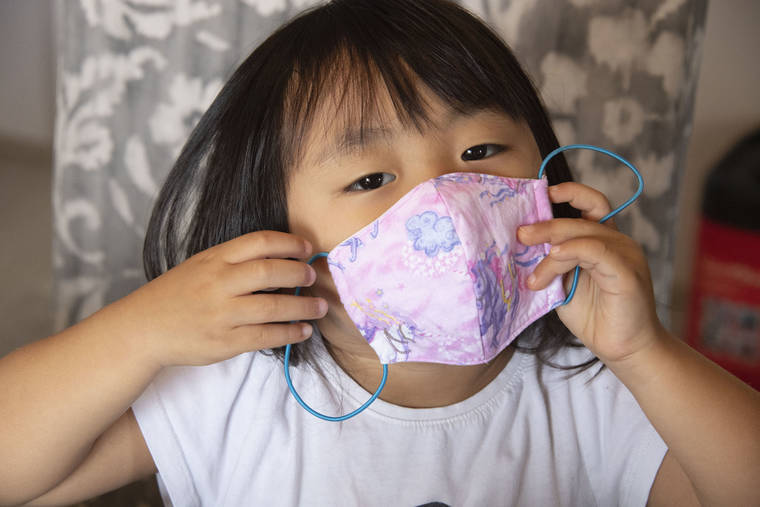VIDEO: Mililani woman shows you how to sew your own fabric face mask

CRAIG T. KOJIMA / CKOJIMA@STARADVERTISER.COM
Mililani resident Aki Shin has stepped up production of fabric face masks at home since taking a voluntary furlough from her job at Hawaiian Airlines.

CRAIG T. KOJIMA / CKOJIMA@STARADVERTISER.COM
Mililani resident Aki Shin has stepped up production of fabric face masks at home since taking a voluntary furlough from her job at Hawaiian Airlines. Daughter Amy Shin wears a fabric face mask.


Mililani resident Aki Shin, 37, took a voluntary furlough from Hawaiian Airlines earlier this month and has been spending some of her time sewing fabric face masks for her ohana and friends.
Shin found her calling for sewing masks in February when missionary friends in Japan mentioned masks were hard to come by during the middle of pollen and hay fever season.
“Maybe if I make some and give it to them — that’ll be a good gift,” she said.
She was right.
Shin experimented with cutting fabric and sketching out her own patterns to sew keiki and adult face masks.
Since creating her first mask, Shin estimates she has sewn over 100 masks for anyone who has asked her.
Don't miss out on what's happening!
Stay in touch with breaking news, as it happens, conveniently in your email inbox. It's FREE!
Now Shin has shared her own patterns with Star-Advertiser readers along with sewing tips. She hopes to help others who want to sew their own masks at home.
“It’s very easy to do once you learn it,” she said. “I will show you how to make masks at home from basic (materials).”
Below are the instructions and materials needed to make a fabric face mask courtesy of Shin.
“Happy sewing,” she said.
RELATED STORIES
>> Mililani woman on a mission to create fabric face masks
>> Where to purchase or find a face mask in Hawaii
>> Retailers, community, stepping up to provide fabric face masks during coronavirus pandemic
VIDEO TUTORIAL
REQUIRED MATERIALS
>> One rectangular piece of cotton fabric (or cut pieces from an old cotton T-shirt):
For a large mask, you will need a 7-1/2-by-12-inch fabric.
For a regular mask, you will need a 7-by-11-1/2-inch fabric.
For a keiki mask, you will need a 6-by-10-inch fabric.
For a toddler mask, you will need a 5-1/2-by-9-inch fabric.
>> One soft fabric (or T-shirt) for the liner:
For a large mask, you will need a 7-1/2-by-10-inch fabric.
For a regular mask, you will need a 7-by-9-1/2-inch fabric.
For a keiki mask, you will need a 6-by-8-inch fabric.
For a toddler mask, you will need a 5-1/2-by-7-inch fabric.
>> Two pieces of 10-inch elastic (if not available, use rubber bands, ribbons, cloth strips or hair ties) for the ear loops
>> Pencil, color pencil or marker
>> Bobby pin
>> Scissors
>> Needle and thread
>> Mask pattern in your preferable size (download Opens in a new tab the PDF pattern Opens in a new tab)
OPTIONAL MATERIALS
>> One rectangular piece of cotton fabric (to provide more stability):
For a large mask, you will need a 7-1/2-by-12-inch fabric.
For a regular mask, you will need a 7-by-11-1/2-inch fabric.
For a keiki mask, you will need a 6-by-10-inch fabric.
For a toddler mask, you will need a 5-1/2-by-9-inch fabric.
>> Flexible nose piece material (twist tie or pipe cleaner)
>> Iron
>> Sewing machine
INSTRUCTIONS
1. Place the rectangle cotton fabric facing down on a hard flat surface such as a table. Iron the fabric stabilizer onto the back of the cotton fabric. These two pieces will be sewn together to create two layers of fabric.
2. Place the cutout mask pattern of your choice on top of the cotton fabric, leaving a 1-1/2-inch space to the straight edge of mask pattern. Using a pencil or color pencil, draw a line around the mask pattern leaving a tracing on the cotton fabric. Use a yellow color pencil if your cotton fabric is a darker shade. This line will be your stitching line.
3. Flip the mask pattern over and repeat step No. 2. Make sure your second piece is mirroring the one in step No. 2.
4. Place a soft fabric for the liner facing down on the table. Place the mask pattern but leaving only 1/2-inch space to the straight edge of the mask pattern. Using a pencil or color pencil, draw a line around the mask pattern, leaving a tracing on the soft fabric. This line will be be your stitching line.
5. Flip the mask pattern over and repeat step No. 4. Make sure your second piece is mirroring the one in step No. 4.
6. Using scissors, cut the cotton fabric and the soft fabric. When cutting the cotton fabric, make sure to leave 1-1/2-inch seam allowance (inlay) from the straight edge of your stitching line. Cut the rest of fabrics by leaving 1/2-inch seam allowance. The soft liner fabric only needs a 1/2-inch seam allowance all around.
7. Pick up the two pieces of cotton fabric and stack them together by putting the face of the fabric inside, exposing the stitching line you drew in steps No. 2 and 3. Do the same thing with the soft liner fabric.
8. Sew the long curvy edge of the cotton fabric by following the stitching line.
9. Sew the long curvy edge of the soft liner fabric by following the stitching line. Then choose one side of mask liner and fold the edge twice. Iron if you prefer, then sew down the edge. (This side of the edge will become an opening for your filter pocket at the end. See step No. 16.)
10. Open up both the cotton fabric and soft liner fabric. Stack them together by putting the faces of fabric inward, making sure the center is aligned. You will see the seams from steps No. 5 and 6 are exposed outward on both sides.
11. Sew the cotton and liner fabrics together at the top and at the bottom of mask along the stitching line.
12. Flip the mask inside out from either side.
13. Iron both the top and bottom edges of mask. Gently pull the fabrics away so they will completely open apart at the stitch line. Iron the edges. If no iron, use your fingertips to scratch on the edges to fold them flat.
14. Nose wire (optional): Insert a twist tie or pipe cleaner from the opening on the side and place it at the center of the top edge.
15. Sew 1/2 inch away from the top edge of the mask. (If you added a nose wire, make sure your stitches are gripping the nose wire against the top edge of the mask.) Also, sew 1/2 inch away from the bottom edge of the mask.
16. Place your mask on the table with the liner side up. Work on the side you finished in step No. 9, folding the seam allowance of the cotton fabric twice until the edge meets the finished liner fabric edge. Iron or use your fingertips to fold down well. Sew the folded edge of the cotton fabric to create a hem for the elastic, making sure your stitches are away from the edge of mask.
17. Start on the other side of mask, folding the seam allowance of the cotton fabric twice. Make sure the folded edge covers the unfinished edge of liner fabric. Also, check to see if the finished size is equal length on both sides from the center by folding your mask in half. Iron and sew the folded edge of cotton fabric to create the hem for elastic and close up the unfinished edge of liner fabric.
18. Now make the ear loops. Using a bobby pin, secure the elastic onto the bobby pin and move it through the hem, leading the elastic until it comes through the fabric. Repeat on the other side.
19. Tie your elastic loosely and adjust the elastic length to best fit your face. Tighten the knots and gently pull on the elastic so that the knots are tucked inside the hem.
20. Optional: Insert the nose wire from the filter pocket and place it against the top edge of your mask. Simply sew along the bottom edge of the wire, about 1/2 inch away from your stitch line to secure it. Add a filter in the filter pocket.
FACE MASK PATTERNS
Download a PDF of Shin’s patterns below. Can’t view the document? Try this link. Opens in a new tab
Important note: The patterns are the stitching lines not the cut lines of the fabric. You will need to add a seam allowance around the pattern before cutting out the fabric. Please refer to the instructions above.
Face Mask Pattern by Aki Sh… by Honolulu Star-Advertiser on Scribd
If you make a face mask from the instructions, please share your creation by tagging Star-Advertiser with a photo on Facebook Opens in a new tab or Instagram Opens in a new tab.
DIY FABRIC FACE MASK (NO-SEW METHOD)
Don’t own a sewing machine? Watch the video below to find how to make a fabric face mask without touching a sewing machine. Get the full instructions here.
——
Editor’s Note: Fabric face masks are not guaranteed to filter out viruses such as the coronavirus. The CDC does not recommend cloth face coverings for children under the age of two, anyone who has difficulty breathing or may be unable to remove the mask without assistance.
Star-Advertiser staff photographer Craig T. Kojima contributed to this report.






